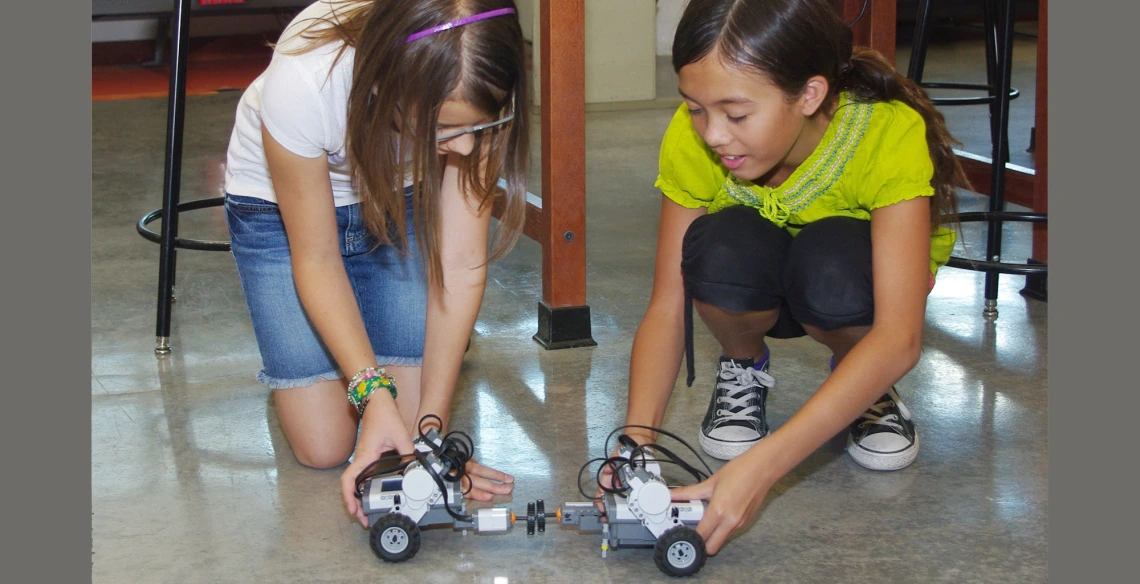RoboClub Rules for Budding Engineers
Lego Robotics Summer Workshops expose kids to the fun side of math and physics and help them see the connections between what they are learning.

Young students learn math and physics at robot camp while having fun with Lego.
"It looks like Wall-E," the young robotics student shouted with glee as his robot hit an obstacle and tilted back with its optical sensor probing the air.
Wall-E, Pixar's computer-animated comedic Prometheus, and the robots children are building at the University of Arizona this summer share more than just good looks — they're both fun for kids.
Exposing this fun side of math and physics is what the Lego Robotics Summer Workshops are all about. Too often, K-12 students miss the applications side, the exciting side, of their math and science classes, and don't see the connection between what they're learning and its possibilities for having a good time, says professor of aerospace and mechanical engineering Eniko Enikov, who created the robot camp.
The workshops, which cost $60 per student, are geared toward children in grades 5 to 8 on Monday and Tuesday and for grades 9 to 11 on Wednesday and Thursday. They've been offered in the Aerospace and Mechanical Engineering building for 12 weeks this summer and will end in early August.
Early Adopters
The workshops are particularly important for younger students, Enikov emphasized. "My colleagues in the College of Education say students need to develop an interest in science and math in the lower grades because that's when they're making decisions about their interests and what they will study," he said. "If they haven't gotten on the math and science track by the time they're in high school, it's often too late for them to catch up."
Each student starts by building a robot from a Lego Mindstorms NXT 2.0 kit, which couples Lego building blocks with a programmable microcomputer brick.
Gordon Bates, a mechanical engineering junior, guides students through this process and, later, through programming by projecting the image of his computer screen on a wall. "I'm using the software at the same time they are. So I tell them to go here and grab this block and place it, and then show them how to set the various parameters," he said.
After the robots are up and running, the students spend the remainder of the two days modifying them by adding sensors and writing programs. This is done with the easy-to-use graphical software included in Mindstorm kits. "Even the 5th graders can understand how to do this," Bates said. "You don't need to know anything about computer programming."
"We start by programming the robots to drive forward for four seconds," Bates explained. "Then I ask them to calculate how to make it go exactly five feet using what they know about how far it travels in four seconds." This involves measuring the circumference of the wheels and calculating the number of rotations needed.
Helping Hand
It's up to the students to figure out how to solve the problems, but if no one can find a solution, particularly the younger students, Bates helps out. "I might put a chalk mark on a robot wheel, for instance, and show them the circumference is the same as the distance it rolls in one rotation. I tell them that's what circumference means."
Later, students measure how far the robots will travel in different time intervals, graph this data using Excel and then calculate the average velocity from the slope of the graphed line.
Students start to realize the value of math they've learned in class and see real-world examples of things that may have been only abstract concepts before, such as the circumference of a circle, Bates said. "Maybe they've memorized the formula and can calculate it when asked, but don't realize how that would apply to the rollout of a wheel, for instance. So circumference becomes a real idea to them, not just a word and equation they've memorized."
The students write seven or eight programs over the two-day workshop. These include using a touch sensor that causes the robot to reverse directions when it hits an obstacle, and a light sensor that allows it to find its way out of an enclosure.
"We have black tape in a rectangle that includes a small opening in one side," Bates explained. "The students program their robot to drive forward until it detects the tape. Then it will back up, turn a little and drive forward again. Eventually, it finds its way to the opening and escapes."
This is the fun way to learn and "by the end of the second day, the students are usually asking where they can get these robotic kits and how much they cost," Bates said.
Robot Soccer
On one recent afternoon, during a grades 5 to 8 workshop, Ryan Hunt was speculating that one of these kits might show up for his birthday, while Isabella Bryant, his teammate in robot programming, said she liked building robots.
The Mindstorm kits, which cost about $280 each, came to UA through a grant from Tufts University Center for Engineering Education and Outreach, and many of the robot experiments are from the Tufts 2008 Lego Engineering Conference report, Enikov said.
Mahdi Ganji, a mechanical engineering doctoral student, developed programs for some of the more complex robotic functions. He adapted a third-party motion sensor to a Lego controller, which allows students to remotely control the speed and direction of a robot soccer player by tilting the controller.
The robot workshops usually end with a boisterous half hour of robot soccer in which students pit two of these remotely controlled players against each another.
Now that's fun.

